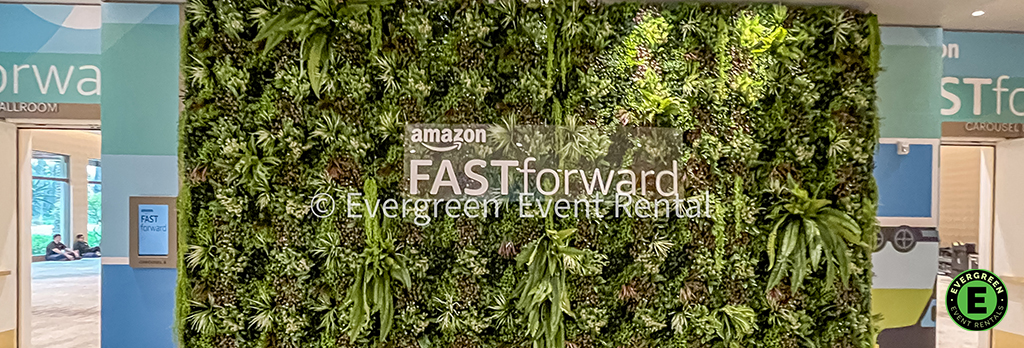Crafting Spectacular Event Experiences: The Art and Science of Creating Custom Artificial Living Walls

INTRODUCTION
In the vibrant sphere of event planning, a novel trend has emerged, exuding an aura of natural elegance and visual appeal – the Artificial Living Wall. A concept that seamlessly blends the allure of nature with the practicality of artificiality, these Living Walls have begun to redefine the aesthetic landscape of diverse events, from intimate soirees to grand corporate gatherings.
This article offers an intriguing glimpse into the world of Artificial Living Walls, a world where creativity is limited only by the boundaries of imagination. As we delve into the behind-the-scenes intricacies of creating a custom Artificial Living Wall, we will embark on a journey of discovery, unearthing the creative process that transforms a simple idea into a captivating visual spectacle.
At its core, an Artificial Living Wall is an installation composed of faux plants that are designed to mimic the lush greenery of a living wall. These installations, however, transcend their physical components, embodying a unique blend of aesthetics, sustainability, and versatility. They serve not merely as decor, but as dynamic focal points that can enhance the ambiance of any space and elevate the overall event experience.
The creation of an Artificial Living Wall is a meticulous process, a symphony of careful planning, strategic design, and attention to detail. It is a process that begins with a vision, an idea born out of the unique needs and desires of each client. This vision then serves as the cornerstone of the design process, guiding the selection of plants, the layout, and the integration of additional design elements.
The creation of an Artificial Living Wall is not a static process, but rather a dynamic journey that evolves with each step. It is a journey that brings together a diverse range of skills, from artistic creativity to technical proficiency, all coming together to bring a vision to life.
As we explore this journey in the ensuing sections of this blog post, we invite you to immerse yourself in the fascinating world of Artificial Living Walls. Discover the transformative potential of these installations, learn about the process that brings them to life, and gain valuable insights into how they can enhance your next event. Let us embark on this journey together, charting a course through the creative process and unveiling the magic that lies behind the scenes of creating a custom Artificial Living Wall.
I. Conceptualizing the Design
In the world of Artificial Living Walls, the design phase is of paramount importance, serving as the blueprint that guides the entirety of the creation process. This phase involves not only the selection of artificial plants but also the conceptualization of the overall aesthetic and thematic elements of the wall. The design should be a reflection of the event’s theme or the client’s vision, transforming a blank canvas into a visual masterpiece.
The design process begins with an exploration of ideas and inspirations, a brainstorming session that brings together the client’s vision and the designer’s expertise. The type of event, the venue, the client’s preferences, and the intended function of the wall all play a role in shaping the design. The selected artificial plants should not only complement each other but also contribute to the overall aesthetic appeal of the wall. The designer should consider the color palette, the texture, and the size of the plants, as well as how they will be arranged on the wall.
Once the preliminary design has been outlined, it is then refined and fine-tuned until it fully aligns with the client’s vision. The end goal is to create a design that is not only visually stunning but also functional and in harmony with the event’s overall theme.
II. Assembling the Frame
The frame is the foundation upon which the Artificial Living Wall is built. It serves as the structure that supports the artificial plants and holds them in place. The size and shape of the frame are determined by the design and the specific requirements of the event. The frame should be sturdy enough to support the weight of the artificial plants and durable enough to withstand the rigors of event use.
The frame can be made from a variety of materials, including wood, metal, or even plastic. It is usually assembled using screws or nails, and it may be painted or decorated to enhance its visual appeal. The frame may also include a backing material, such as mesh or netting, to which the artificial plants are attached.
III. Attaching the Artificial Plants
Once the frame has been assembled, the next step is to attach the artificial plants. This process involves carefully arranging the plants according to the design and securing them to the frame. The artificial plants can be attached using a variety of methods, including staples, ties, or adhesive. The method used will depend on the type of plants, the material of the frame, and the overall design of the wall.
This stage of the process requires a keen eye for detail and a steady hand. Each plant must be positioned precisely according to the design, and care must be taken to ensure that they are securely attached. The goal is to create a seamless, natural-looking arrangement that brings the design to life.
IV. Adding Finishing Touches
Once all the artificial plants have been attached, the final step is to add the finishing touches. This may involve adding additional elements to the design, such as decorative items or lighting, or making minor adjustments to the arrangement of the plants. The finishing touches serve to enhance the overall aesthetic appeal of the wall and to ensure that it fully aligns with the client’s vision.
The finishing touches are the final flourish, the last stroke of the artist’s brush that completes the masterpiece. They are the subtle elements that make the difference between a good design and a great one. Whether it’s a strategically placed spotlight that highlights the textures of the plants, a decorative item that adds a touch of elegance, or a final adjustment to the arrangement of the plants, the finishing touches are what make the Artificial Living Wall truly come alive.
V. Installing the Wall
The final phase of the process is the installation of the Artificial Living Wall at the event venue. This involves transporting the wall to the venue and positioning it in #2. Conceptualizing the Design
Picture this: an empty canvas longing for creative strokes, an orchestra poised for a maestro’s guidance, a stage awaiting its protagonist. This is the enchanting phase of conceptualizing the design for your Artificial Living Wall. Here, ideas sprout, visions solidify, and a surreal Selfie Wall starts to take form. It’s a process of fusing the event’s ethos with the aesthetics of nature, creating a spectacle that will add charisma to your event.
In this brainstorming phase, the event type, the venue’s ambiance, and client’s preferences are all critical. The chosen plants should not only harmonize among themselves but also embody the overall aesthetic of the wall. Consideration for color, texture, plant size, and arrangement will be paramount to ensure that the wall’s design is as captivating as it is cohesive.
After the preliminary design is sketched out, it’s time for refining and perfecting. The goal is to materialize a design that’s visually mesmerizing, functional, and in perfect sync with the event’s overall theme.
CONCLUSION
We have traversed the fascinating journey of creating a custom Artificial Living Wall, a journey that takes us from the initial conceptualization of the design to the final installation at the event venue. Along this journey, we have delved into the various facets of the creation process – the brainstorming and conceptualizing of the design, the construction of the frame, the careful placement and attachment of artificial plants, and the addition of final finishing touches.
Creating an Artificial Living Wall is akin to painting a picture or composing a symphony – it is a process that involves creativity, meticulousness, and a keen eye for detail. Each step of the process contributes to the final product, a stunning Selfie Wall that not only enhances the aesthetic appeal of the event but also promotes engagement and interaction among attendees.
Artificial Living Walls are more than just a decorative element; they are a powerful tool for creating an engaging and immersive event experience. They add a touch of nature and vibrancy to the venue, creating a backdrop that is visually stunning and highly photogenic. As attendees capture and share their photographs against the backdrop of the Selfie Wall, they become active participants in the event, enhancing the event’s visibility and reach.
In conclusion, the process of creating a custom Artificial Living Wall is both an art and a science. It requires a blend of creativity, technical skill, and a deep understanding of aesthetics and design. The result is a captivating Selfie Wall that enhances the event’s ambiance, promotes attendee engagement and contributes to the overall success of the event. Through this process, we see how innovation and creativity can transform a simple concept into a powerful tool for enhancing event experiences.
Looking to purchase Artificial living walls for your home or business? Visit Geranium Street today!



